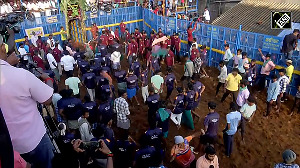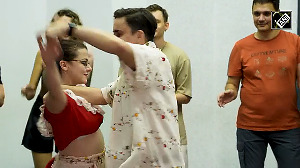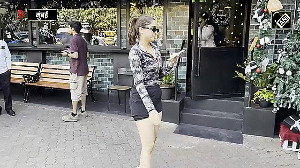Prime Minister Narendra Modi, who will be the second Indian prime minister to visit Fiji after Indira Gandhi, comes at a time when the islands are moving to consolidate the new democratic system, says Shubha Singh.
India has had close links with Fiji Islands, as it is home for a substantial minority of people of Indian origin who have a strong sentimental attachment to India. Prime Minister Narendra Modi is due to visit Fiji Islands, an archipelago in the heart of the South Pacific Ocean, on November 19. 
The last Indian leader to visit Fiji Islands was former prime minister Indira Gandhi in 1981-- a visit that is still remembered by Fiji’s old-timers. It was just a decade after Fiji’s independence, when the sunny island nation in the South Pacific Ocean was still lauded for its smooth transition from a British colony to a harmonious multi-ethnic democracy.
During this period, Fiji’s government was headed by Ratu Sir Kamisese Mara, whose ruling Alliance Party comprised largely of indigenous Fijians with some Indian and other minority support. This was before political rivalry between the two main races, the indigenous Fijians and ethnic Indians, exacerbated in a tussle that culminated in a series of coups.
PC Alexander, who had a distinguished innings as principal secretary to the prime minister, described Mrs Gandhi’s two-day visit to Fiji in his memoirs (My Years with Indira Gandhi) as a memorable one for it was the fulfillment of a long cherished dream of Fiji’s Indian community.
It was a day of great rejoicing for Fiji Indians. Indira herself was deeply touched by the warmth and spontaneity of the welcome by Fiji’s Indian community. Alexander related how the magnificent reception she received made the Indian delegation feel that they were on a visit to an Indian state ‘with the same kind of rapturous crowds lining the streets, enthusiastic people running along either side of the prime minister’s car, wild cheering, bouquets and flowers thrown at her and mothers thrusting their children for her to fondle.’
The indigenous Fijian society is a tribal society which lays great emphasis on tribal norms and rituals. Important guests to Fiji get the full elaborate, traditional welcome due to a visiting high chief as part of the official welcoming ceremonies.
According to Fijian tribal tradition a visitor is formally welcomed with a ceremony that requires drinking a bowl of yaqona or kava. Kava is made from the powdered roots of the kava plant that belongs to the pepper family; it is not alcoholic but has mild soporific effect if taken in large quantities.
The ceremony takes place in a large open ground with a wooden platform where the dignitaries and the hosts are seated, while the welcoming chiefs sit on the ground. The heralds of the high chiefs chant the welcome songs and praises of the visitor in the Fijian language and then make presentations of welcoming gifts of fruit, pigs, reed mats, and intricate baskets. A herald representing the visiting dignitary responds to the praises and welcoming chants in similar vein. In an elaborate ritual the yaqona powder is mixed with water and strained through bark cloth amid chanting.
Alexander described the scene thus: 'The chief poured the liquid into a small wooden cup and holding it with both hands approached Mrs Gandhi with great reverence and offered the cup to her. We were waiting to see what Mrs Gandhi would do with this concoction, but just as was expected from a ‘Big Chief’, she emptied the cup in one drink without showing any sign of uneasiness or embarrassment. The entire crowd broke into loud applause at this gesture.' 
India’s leader being honoured in the traditional Fijian yaqona ceremony had great symbolic significance for the Fiji Indians. And Indira’s aplomb at the elaborate ceremony was greatly appreciated. The bowl of kava is meant to be quaffed down in one go. Fiji national and columnist Bhaichand Patel recalls watching a welcoming kava ceremony for Queen Elizabeth II in the mid-1950s when she drank the cup of yaqona and involuntarily made a wry face at the taste.
Modi will also be welcomed with a similar combination of an elaborate Fijian ceremony and popular enthusiasm by the Indian community. There is a new mood in Fiji after the elections held on September 17 ended an eight-year long military rule and brought in a new democratic government. A new constitution and revised electoral system based on one-man one-vote changed the race-based politics of Fiji. Former military chief, Voreqe Bainimarama’s newly formed political party, FijiFirst Party won over 59 per cent of the votes polled, gathering support from all the main ethnic groups in the country. Fiji has had a history of coups; in 1987, 2000 and 2006 elected governments were toppled by people unwilling to accept the legitimate government.
Fiji Islands became a British colony in 1874 when the tribal Fijian chiefs ceded the islands to the British crown. When the colonisers required labour to work on the sugarcane plantations, about 60,000 Indians were brought as indentured labourers to Fiji over a period of more than three decades. In the early decades of the 20th century, Gujarati traders began arriving in Fiji to set up small businesses; there is now a thriving Gujarati community that dominates the retail sector in Fiji. The majority of the Indians in Fiji are descendants of those indentured workers and early Gujarati migrants. 
Indians form 37 per cent of Fiji’s population while the indigenous Fijians are 54 per cent. Relations between the two main ethnic groups have largely been harmonious, but politics has accentuated racial divisions in Fiji. Under the earlier electoral system, elections were held on separate racially based constituencies and electoral rolls. A new constitution, new electoral system and new government voted in with the support of all ethnic groups have brought Fiji back to the path of democracy. Modi will be the first foreign dignitary to visit Fiji as it moves to consolidate the new democratic system.











 © 2025 Rediff.com -
© 2025 Rediff.com -